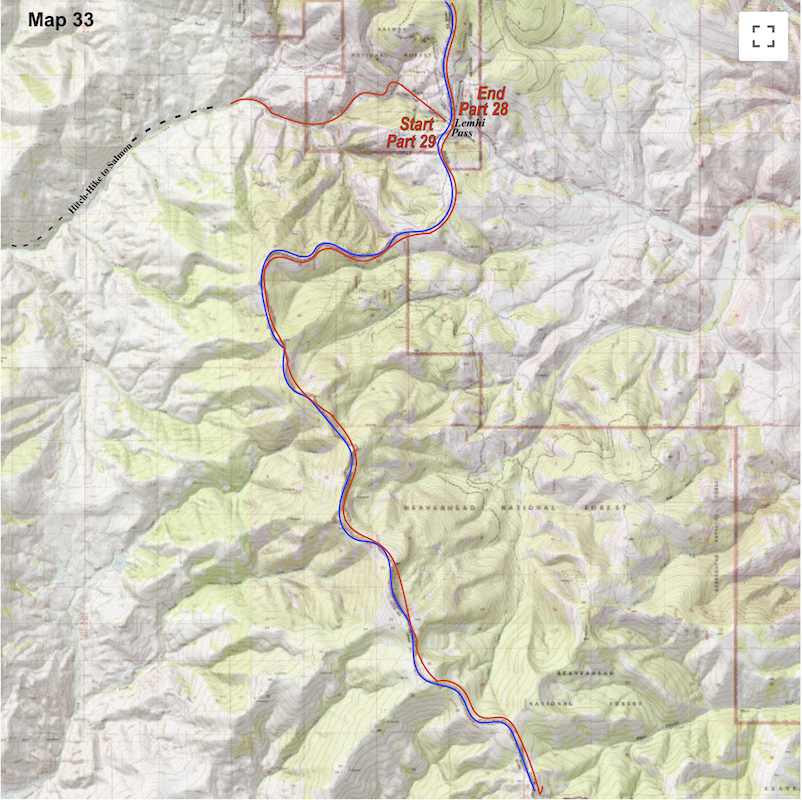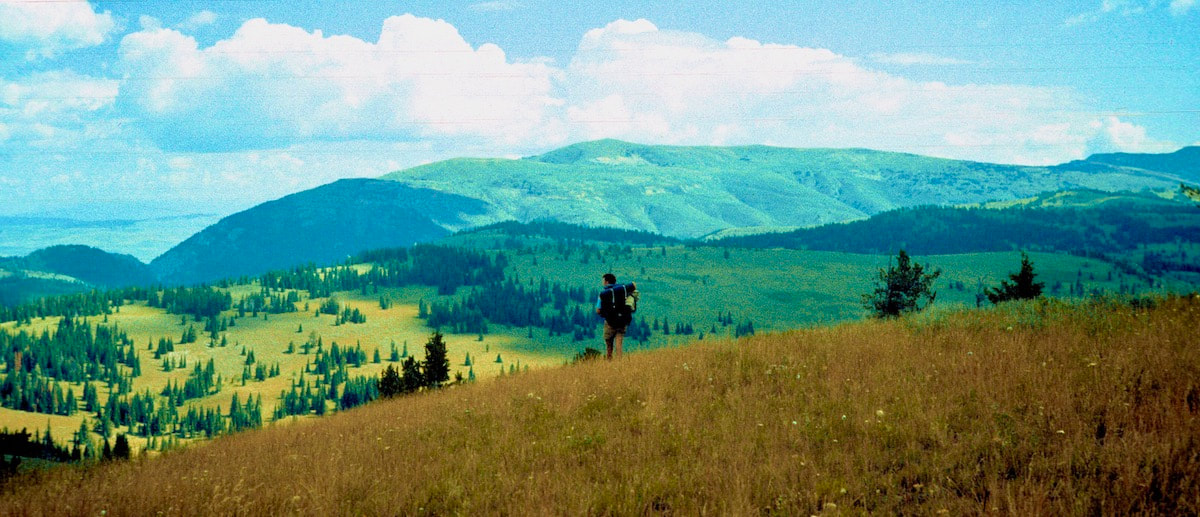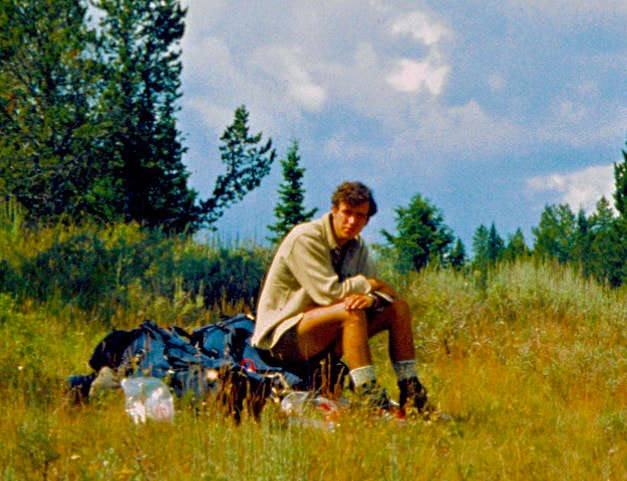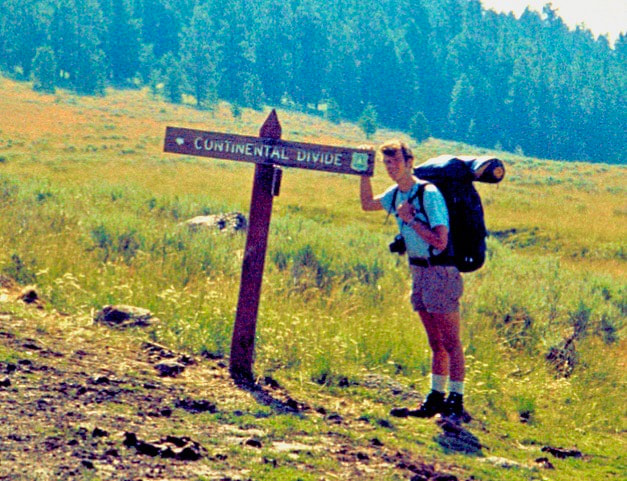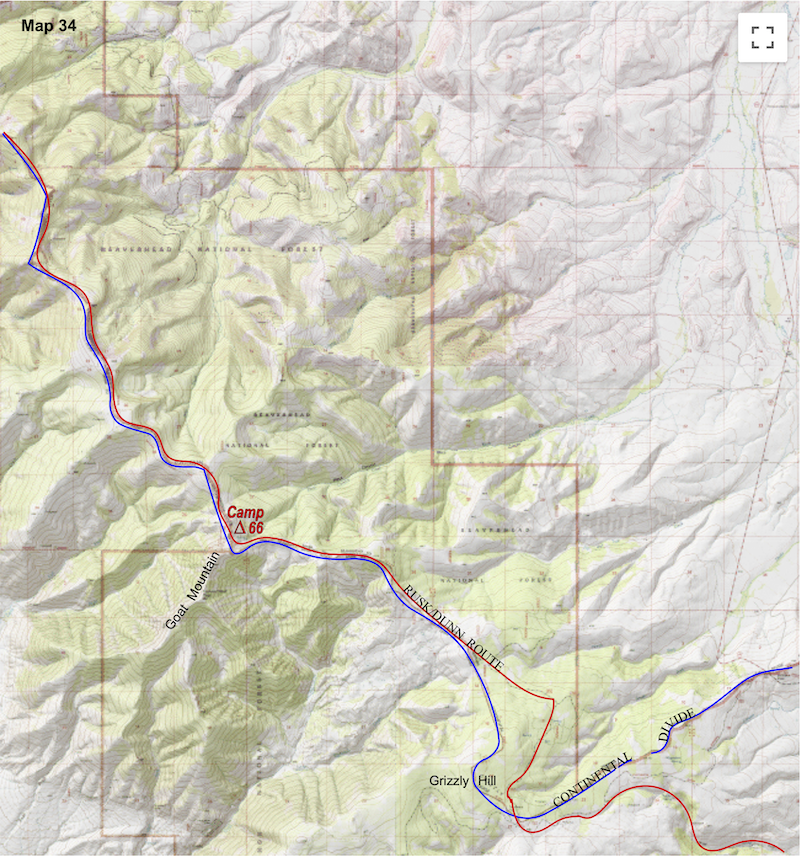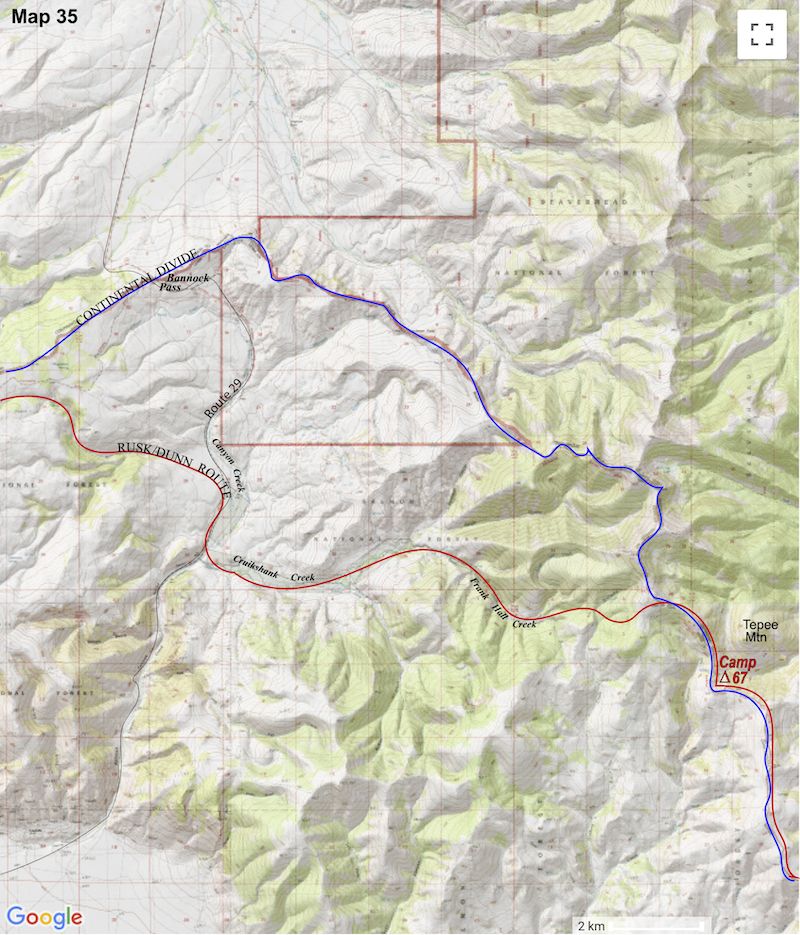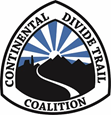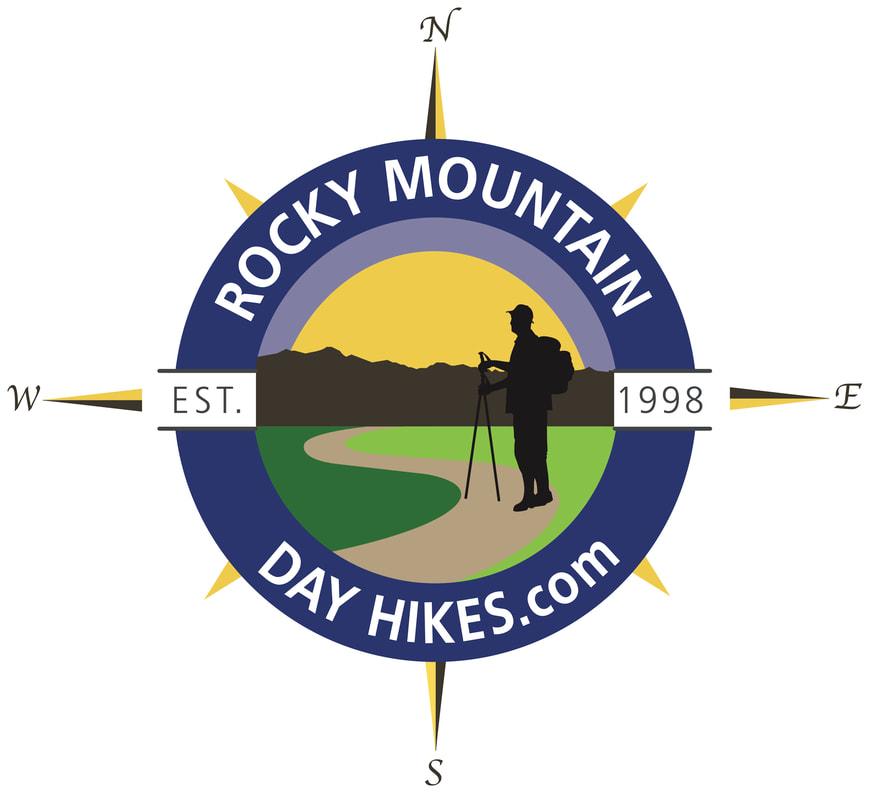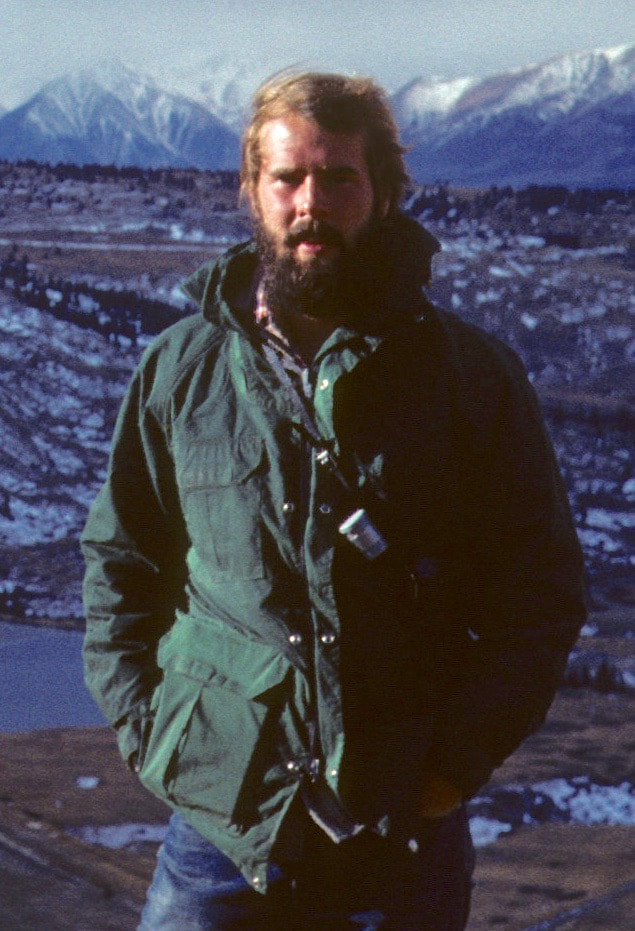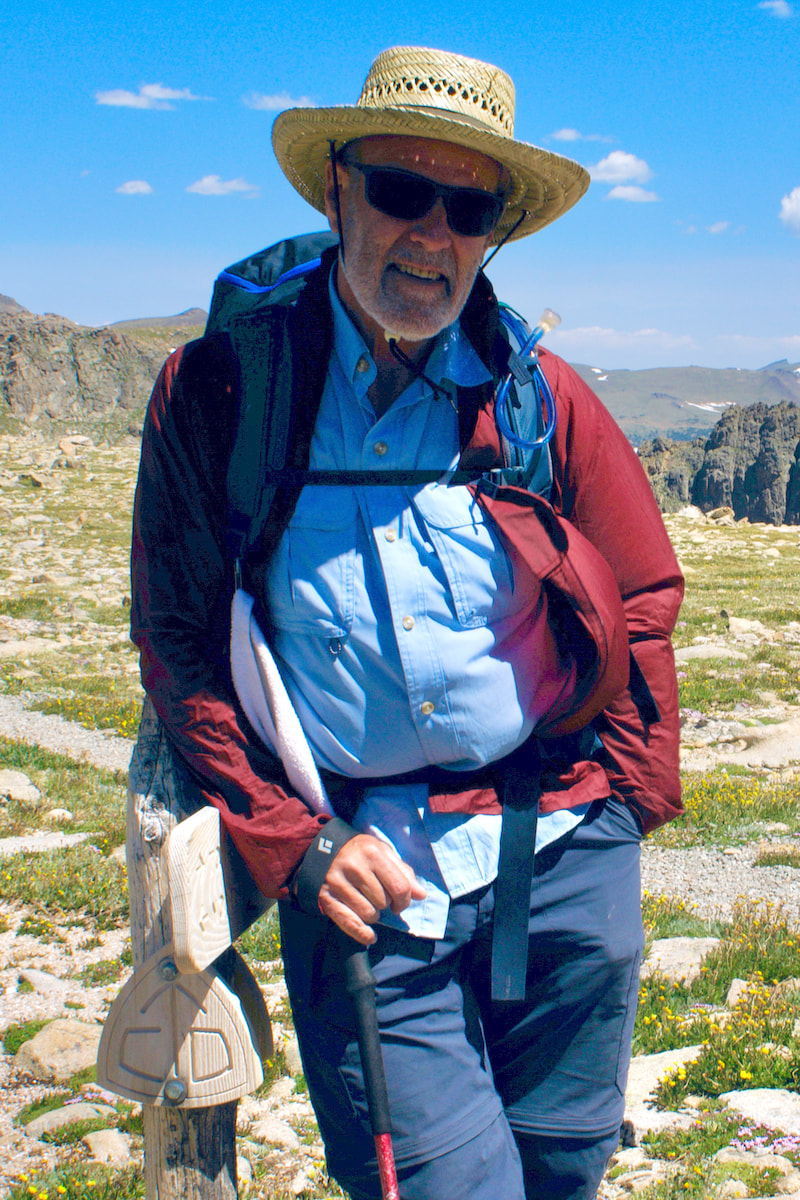The Continental
|
|
July 31-August 1 Salmon, ID (Go to Pt 1) We arrived at the top of Lemhi Pass a little after 1:00 p.m. and wasted little time getting pack-saddled and heading-off south on a hammered-out, rock and dust road that snaked its way along the crest of the Divide. Being on the front end of another two week stint meant our packs were loaded and burdensome again but we still hoped to stretch the remainder of the day out to cover at least 14 miles.
After hiking for an hour or so, the parched, sage covered slopes met up to a stand of tall pines which, in a matter of steps, closed us into a shadowy forest. Over the next eight miles or so the forest would break intermittently to afford views of differing aspects, sometimes east, sometimes west or south, as the trail ambled and undulated along the rolling crest of the Divide. Without a single obstacle in our path or any navigational worries to mind to, both the road and the terrain allowed us to accelerate our pace and move quickly along the route, which was nice for a change but also tiresome in a monotonous kind of way. Around 6:30 p.m. the road finally petered out at the saddle below Goat Mountain’s broad, north ridge. We ambled across the open, north slope and located the spring that was shown on our map then settled for a lumpy, pint-sized tent platform on the grassy hillside just up from the spring. It was a warm, calm evening with a light, summer breeze and, as we suddenly realized in astonishment, no bugs!
Earlier, while we sat eating lunch and swatting horseflies into the dirt, we watched an epic, fight-to-the-death struggle unfold right before our eyes. Several of the flies we had swatted down had hit the ground stunned, most with a busted wing or two, but not dead. Well, where there were no ants before, these hapless flies on the ground, stunned, bleeding and flailing about, suddenly brought out columns of red ants from a rotting log maybe ten yards away, marching across the pebbly gravel toward the flies. It did not take long for the ants to cross what for them was one heck of a long boulder field and engage the wounded horseflies. However, once the ants reached the killing field they quickly discovered the horseflies too aggressive and too angry for just one or even several ants to handle. It took at least ten or more ants to subdue a fly and then those ants struggled mightily as they tried to get all their combined legs to pull the bucking horsefly in the same direction. And thus, a fight to the death ensued. This was some really cool shit! I mean, when you’re out walking the Continental Divide, scenes like this are intensely interesting to watch; it was the Nature Channel Live, in HD, 3D, Monster-Vision! So, with the six or seven flies on the ground well under control, the remaining columns of ants began to march past the crippled horseflies, looking intent on bringing something else down which was probably going to be our sausage and crackers. And to be sure, once they smelled fly blood in the dirt and sausage grease in the air, they began to swarm in rapidly increasing numbers. We were pretty mesmerized by this whole insect scene going on until an ant column snuck around my left flank to reach my boot sole undetected and we were suddenly alarmed into a defcon1, lunch pack-up and rapid retreat, leaving the ants conquerors of the ground.
After a couple of miles, the track filtered out of the trees and down to a meadowy saddle, maybe a mile across, with open slopes rolling away to the southwest. Little Eightmile Creek trickled down through the meadow below the ridge, gaining momentum as it gathered down the hillside to splash its way through a series of diamond-set ponds that glittered for nearly a mile down the grassy mountainside.
We took a late lunch sometime mid-afternoon under a hot patch of shade just downstream from the headwaters of the creek. The sun was intense and I was beginning to feel weak and washed-out under the oppressive heat. I was sure the crest of the ridge was not far off but when I checked the map to see if we were close, I saw instead another 1,600 ft. vertical rise to get there; I sagged over the map and nearly puked. We had a ragged, 4W track to get us started up, out of the valley then we hung to open slopes to reach Quaking Aspen Creek. From there we trudged up a long, steady grind through hot, brittle pines to a clearing on the ridge. We dropped our packs in the dust and pulled hard on our water bottles. I was toast and my feet were pleading with me to ‘get these damn boots off!’ From the top of the ridge we only had a couple of moderately easy, downhill miles to reach camp but the thought of having to re-saddle that flippin’ pack had me pissed-off to the point of loudly barked expletives.
We spent about an hour hunkered behind the meager protection of a couple of crispy-fried, pine hags until the sun lowered enough to venture back out and pitch camp. Go to Part 32
0 Comments
Leave a Reply. |
Kip RuskIn 1977, Kip Rusk walked a route along the Continental Divide from Canada to Mexico. His nine month journey is one of the first, documented traverses of the US Continental Divide. Montana Part 1 - Glacier Ntl Pk Part 2 - May 11 Part 3 - May 15 Part 4 - May 19 Part 5 - May 21 Part 6 - May 24 Part 7 - May 26 Part 8 - June 2 Part 9 - June 5 Part 10 - June 7 Part 11 - June 8 Part 12 - June 11 Part 13 - June 12 Part 14 - June 15 Part 15 - June 19 Part 16 - June 23 Part 17 - June 25 Part 18 - June 27 Part 19 - June 30 Part 20 - July 5-6 Part 21 - July 7-8 Part 22 - July 9-10 Part 23 - July 11-15 Part 24 - July 17-18 Part 25 - July 18-19 Part 26 - July 19 Part 27 - July 20-21 Part 28 - July 22-23 Part 29 - July 24-26 Part 30 - July 26-30 Part 31 - July 31-Aug 1 Part 32 - Aug 1-4 Part 33 - Aug 4-6 Part 34 - Aug 6 Part 35 - Aug 7-9 Part 36 - Aug 9-10 Part 37 - Aug 10-13 Wyoming Part 38 - Aug 14 Part 39 - Aug 15-16 Part 40 - Aug 16-18 Part 41 - Aug 19-21 Part 42 - Aug 20-22 Part 43 - Aug 23-25 Part 44 - Aug 26-28 Part 45 - Aug 28-29 Part 46 - Aug 29-31 Part 47 - Sept 1-3 Part 48 - Sept 4-5 Part 49 - Sept 5-6 Part 50 - Sept 6-7 Part 51 - Sept 8-10 Part 52 - Sept 11-13 Part 53 - Sept 13-16 Part 54 - Sept 17-19 Part 55 --Sept 19-21 Part 56 Sept 21-23 Part 57 - Sept 23-25 Part 58 - Sept 26-26 Colorado Part 59 - Sept 26 Part 60 - Sept 30-Oct 3 Part 61 - Oct 3 Part 62 - Oct 4-6 Part 63 - Oct 6-7 Part 64 - Oct 8-10 Part 65 - Oct 10-12 Part 66 - Oct 11-13 Part 67 - Oct 13-15 Part 68 - Oct 15-19 Part 69 - Oct 21-23 Part 70 - Oct 23-28 Part 71 - Oct 27-Nov 3 Part 72 - Nov 3-5 Part 73 - Nov 6-8 Part 74 - Nov 9-17 Part 75 - Nov 19-20 Part 76 - Nov 21-26 Part 77 - Nov 26-30 Part 78 - Dec 1-3 New Mexico Part 79 - Dec 3-7 Part 80 - Dec 8-11 Part 81 - Dec 12-14 Part 82 - Dec 14-22 Part 83 - Dec 23-28 Part 84 - Dec 28-31 Part 85 - Dec 31-Jan2 Part 86 - Jan 2-6 Part 87 - Jan 6-12 Part 88 - Jan 12-13 Part 89 - Jan 13-16 Part 90 - Jan 16-17 Part 91 - Jan 17 End |
© Copyright 2025 Barefoot Publications, All Rights Reserved

